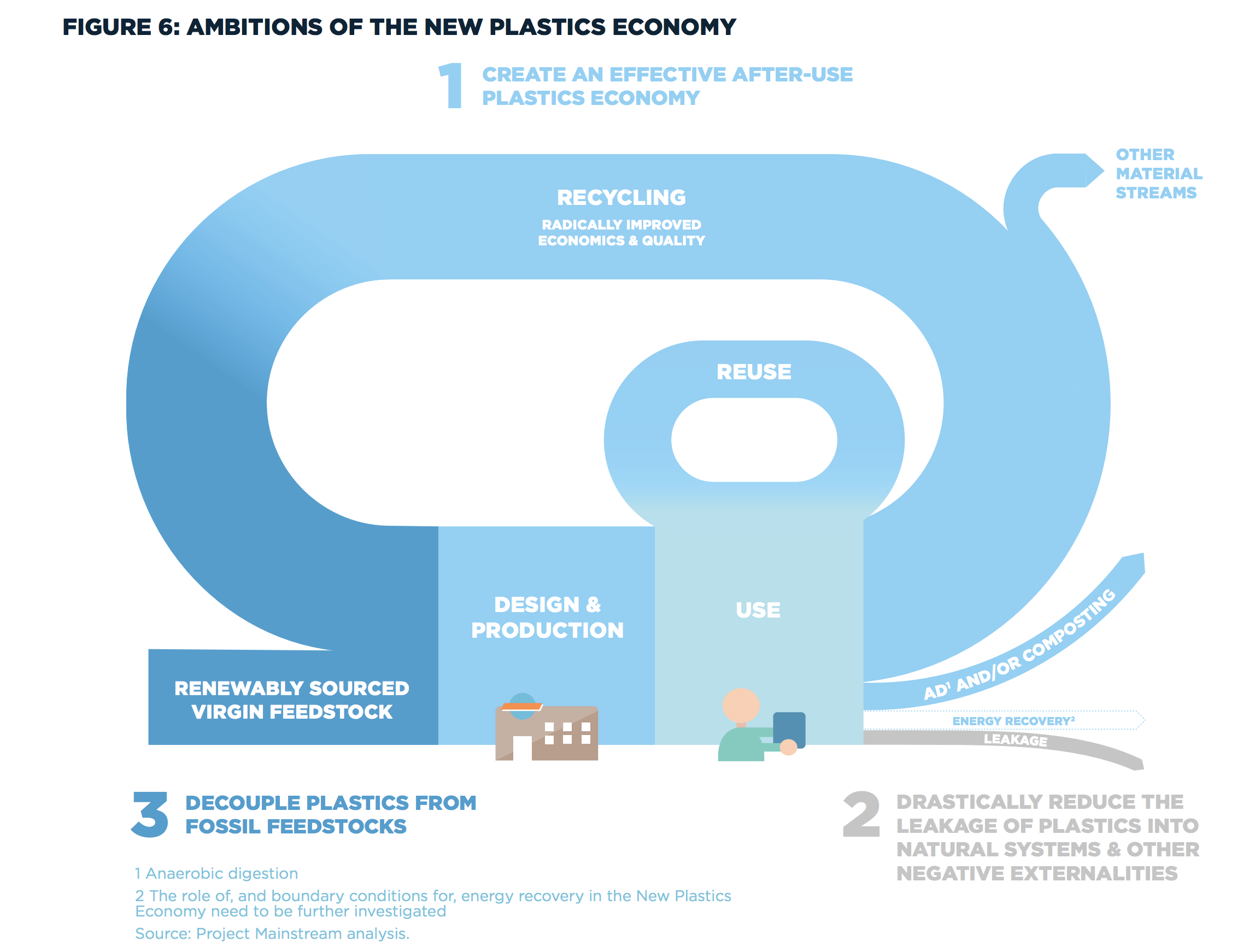While the blog is still in the bioplastics mood, I’ve been hearing more and more about circular economy when it comes to the plastics industry and I came across this interesting study as well as this new three-year initiative called the “New Plastics Economy” (NPEC) led by the Ellen MacArthur Foundation in collaboration with a broad group of leading companies, cities, philanthropists, policymakers, academics, students, NGOs, and citizens.
The NPEC initiative started in January 2016 with the launch of a report (see slideshare below) as a result of a collaborative effort involving more than 40 participant companies and cities across the global plastic packaging value chain. It was produced as part of Project MainStream, a collaboration between the World Economic Forum and the Ellen MacArthur Foundation, with McKinsey & Company as a knowledge partner and led by the CEOs of nine global companies.
The report finds that most plastic packaging is used only once; 95% of the value of plastic packaging material, worth $80-120 billion annually, is lost to the economy. Additionally, plastic packaging generates negative externalities, valued conservatively by UNEP at $40 billion. Given projected growth in consumption, in a business-as-usual scenario, by 2050 oceans are expected to contain more plastics than fish (by weight), and the entire plastics industry will consume 20% of total oil production, and 15% of the annual carbon budget.
Here is a nice video explaining the gist of the report:
The New Plastics Economy, outlined in this report, envisages a new approach based on creating effective after-use pathways for plastics; drastically reducing leakage of plastics into natural systems, in particular oceans; and decoupling plastics from fossil feedstocks.
Achieving such systemic change will require major collaboration efforts between all stakeholders across the global plastics value chain – consumer goods companies, plastic packaging producers and plastics manufacturers, businesses involved in collection, sorting and reprocessing, cities, policymakers and NGOs. The report proposes the creation of an independent coordinating vehicle to set direction, establish common standards and systems, overcome fragmentation, and foster innovation opportunities at scale. In line with the report’s recommendations, the Ellen MacArthur Foundation will establish an initiative to act as a cross-value-chain global dialogue mechanism and drive the shift towards a New Plastics Economy.
Some interesting information from the report below:
- Between 2000 and 2015, the share of plastic packaging as a share of global packaging volumes has increased from 17% to 25%7 driven by a strong growth in the global plastic packaging market of 5% annually. In 2013, the industry put 78 million tonnes of plastic packaging on the market, with a total value of USD 260 billion. Plastic packaging volumes are expected to continue their strong growth, doubling within 15 years and more than quadrupling by 2050, to 318 million tonnes annually — more than the entire plastics industry today.
- The 150 million tonnes of plastics currently in the ocean include roughly 23 million tonnes of additives, of which some raise concern. While the speed at which these additives leach out of the plastic into the environment is still subject to debate, estimates suggest that about 225,000 tonnes of such additives could be released into the ocean annually. This number could increase to 1.2 million tonnes per year by 2050.
- Even if global recycling rates rose from today’s 14% to more than 55% — which would be higher than the rate achieved today by even the best-performing countries — annual requirements for virgin feedstock would still double by 2050.
- Recycling one additional tonne of plastics reduces emissions by 1.1–3.0 tonnes of CO2e compared to producing the same tonne of plastics from virgin fossil feedstock
- Some bio-based plastics also have been shown to have a negative global warming potential with -2.2 kilogram CO2e per kilogram of bio-based PE produced compared to 1.8 kilogram CO2e per kilogram of fossil-based PE produced.
- The use of oil by the plastics industry is expected to increase in line with plastics production (growing by 3.5–3.8% annually); this is much faster than the growth in overall demand for oil, which is expected to increase by
only 0.5% annually.
- Given that Asia accounts for more than 80% of the total leakage of plastic into the ocean — at least according to the best available data — this region has been the focus for a variety of crucial leakage mitigation efforts aimed at improving basic collection infrastructure.
- Europe and the United States are home not only to significant shares of the production of plastic packaging, but also to the overwhelming majority of the top global companies relevant to the global plastic packaging industry, including the key global decision-makers at the start of the plastic packaging value chain — those who determine design. Many of the opportunities around product and material redesign and around innovation in advanced technologies in separation and reprocessing can be found in these regions.




